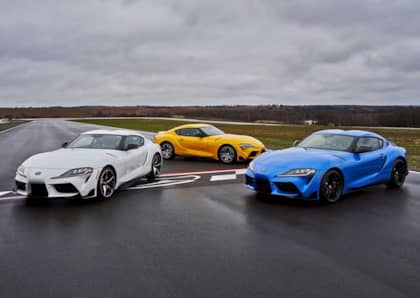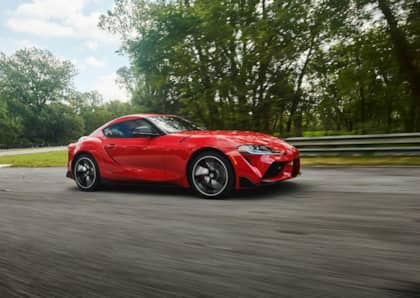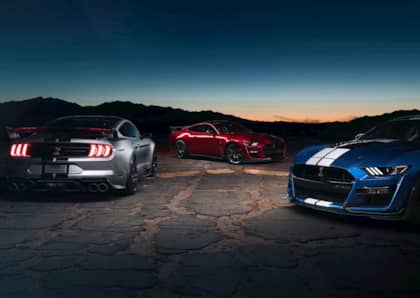The 2021 Toyota Supra Delivers More Power, But Does It Rise Above Its BMW Z4 Roots?
Toyota Supra fans got either a hard-to-swallow snub or a pleasant surprise, depending on their point of view, when the 2021 Toyota GR Supra arrived in dealerships. The crux of the conflict? The second-year model delivered 50 more horsepower than the original A90 model, bringing the total from its 3.0L turbocharged six-cylinder engine to a generous 382 ponies (to go with a modest torque increase to 368 lb-ft).

Those who'd already plunked down their cash at launch were no doubt upset by the sudden performance boost from Toyota's flagship sports car, but for everyone else it's been an unexpected boon. Reading between the lines, however, reveals that the decision to give the Supra more brawn brings it even closer to the BMW Z4 that shares its platform, which had already crested the 380hp mark the year before.

This got us thinking: with near-identical drivetrain specs, and with the Supra being manufactured on the same production line as its topless BMW counterpart, just how different are these two rides from behind the wheel? It's time to pit the BMW Z4 versus the Supra and see just how much changes when you swap from German roadster to Japanese-by-way-of-Bavaria coupe.
Turbo Twins
With the pedal down, there's little to separate the Z4 vs Supra. That's to be expected, considering that they share not just the same engine (for six-cylinder models), but also an eight-speed automatic transmission (from ZF). In a straight line, both cars are good for a 0-60 sprint of less than 4 seconds, and if you extend that race out past the quarter mile marker the two finish in a dead heat just a few ticks north of 12 seconds. This is a vast improvement when comparing the old Supra vs new Supra, with the '90s twin-turbo model nearly a second slower in each measure despite a slight weight advantage.

Each car feels aggressively quick off of the line, with the kind of explosive launch that has become indelibly associated with BMW's turbo six. There's really no difference in throttle response when hammering on either car's accelerator, but switching into manual mode sees the shifts in the Supra knocking out a bit more violently in its most aggressive drive mode.
Rougher Around The Edges
From a suspension perspective, too, the Toyota GR Supra hits harder. Aside from the clear styling differences between the two cars, Toyota's engineers went to great lengths to separate the Supra from the Z4 in terms of chassis setup, and it shows when taking either car close to the limit.

Simply put, with Sport mode engaged the Supra becomes a spine-cracking dance partner more than willing to bounce and chatter its way to the edge of the asphalt when scooting through a set of bends in your nearest country road.

It's a stretch to label the Toyota Supra a pure sports car—its grand touring roots are a little too apparent—but outside of the daily grind the two-seater separates itself from other, similarly-priced luxury coupes with reflexes that should satisfy the vast majority of drivers.

The BMW Z4, while equally competent in 90 percent of the driving scenarios one is likely to encounter in the wild, doesn't quite stretch to the Supra's level of communication or agility. It offers a less granular, and more filtered view of the world as it passes beneath its 19-inch rims, and one that's befitting the customer that typically purchases a BMW roadster (which is positioned as a less-hardcore alternative to class leaders like the Porsche Boxster).
It's What's Inside That Counts
BMW's commitment to a premium driving experience extends beyond its suspension settings to inform its cabin trappings, too. Simply put, the Z4 is a more inviting place to spend time, regardless of whether the top is up or down, and it delivers a more polished presentation than what Toyota has stuffed into the Supra.

And 'stuffed' is the right word. The GR Supra's cockpit is a tight squeeze even for those measuring under six feet, with a low ceiling contributing to a slight sense of claustrophobia.

Despite sharing much of it switchgear with the Z4, Toyota has managed to make the Supra's dashboard and gauges look drab and pedestrian compared to the BMW version of the same. It's not quite up to par with what buyers expect in a $50,000 sports car.
Priced To Part Ways
The good news for BMW and Toyota is, despite the sameness of the two cars from a personality perspective (unless you're really pushing hard), their pricing and styling puts them in two very different segments. The Z4 starts at $10,000 or so more than the Supra, and adding on options can quickly double that gap.

Is the cost crunch the biggest driver for the Supra's humdrum interior, or was that done simply to help further differentiate the Toyota from its luxury-laden sibling? It's difficult to know the full story behind how these twins were raised, so we're unlikely to resolve the nature-versus-nurture debate surrounding the Z4 vs Supra any time soon.

What we do know for sure is that regardless of whether you want to feel the wind in your hair, or would prefer near helmet-like proportions in a proper coupe roofline, both of these cars will deliver speed and style. This leaves it up to you to decide how hard you want your teeth rattled when it's time to get serious about the next apex.











